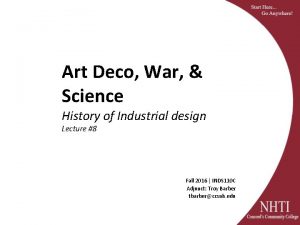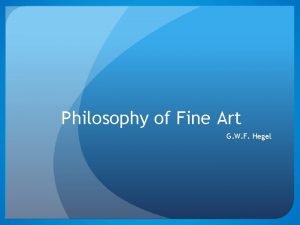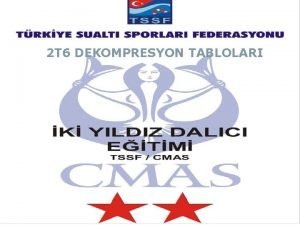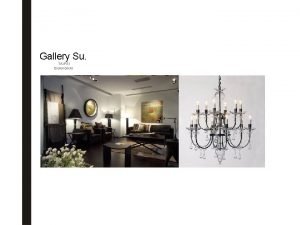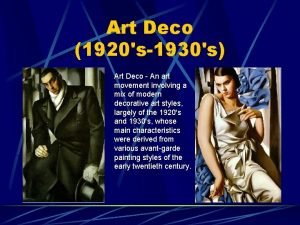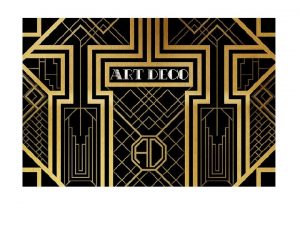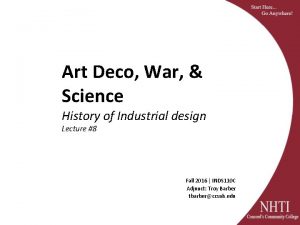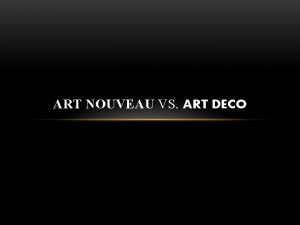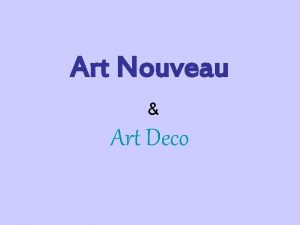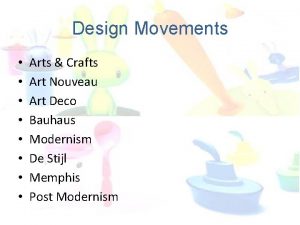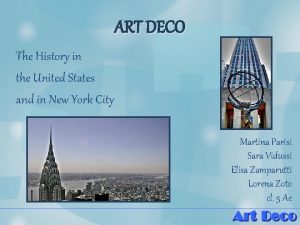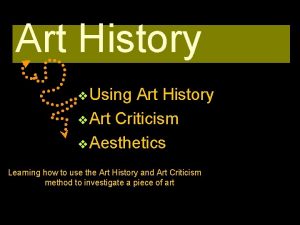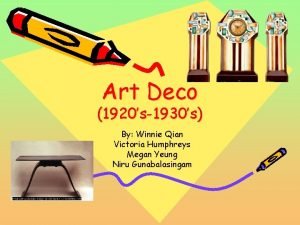Art Deco War Science History of Industrial design





















- Slides: 21

Art Deco, War, & Science History of Industrial design Lecture #8 Fall 2016 | INDS 110 C Adjunct: Troy Barber tbarber@ccsnh. edu

International Exhibition of Modern Decorative and • Industrial Arts in Paris • (1925) April-October, 1925. Sponsored by French government to highlight the new style moderne of architecture, interior decoration, furniture, glass, jewelry and other decorative arts in Europe and throughout the world. • Many ideas of the international avantgarde in the fields of architecture and applied arts were presented for the first time at the Exposition. • Celebration of modernism, not of historical styles. • “…Open to all manufacturers whose products [are] artistic in character and shows clearly modern tendencies. "

Art Deco (1925 -) • Art Deco, or Deco, was an often contradictory design movement that first appeared in France just before World War. • Arts Décoratifs, from the Exposition Internationale des Arts Décoratifs et Industriels Modernes (International Exhibition of Modern Decorative and Industrial Arts) held in Paris in 1925. • Influenced the design of buildings, furniture, jewelry, fashion, cars, movie theaters, trains, ocean liners, and everyday objects such as radios and vacuum cleaners.

Art Deco (1925 -)-continued • Combined modernist styles with fine craftsmanship and rich materials. • Associated with both luxury and modernity; it combined very expensive materials and exquisite craftsmanship put into modernistic forms. • Nothing was cheap about Art Deco: pieces of furniture included ivory and silver inlays, and jewelry combined diamonds with platinum, jade, and other precious materials. • The style was used to decorate the firstclass salons of ocean liners, deluxe trains, skyscrapers, and movie theatres. • Subdued by the Great Depression.

Hermann Muthesius (1861 -1927) Spiritual Founder of the Deutscher Werkbund • Author, architect, and diplomat • Published Das englische Haus ("The English House") in 1904 -1905 after spending 6 years in England. • Returned to Germany extolling the virtues of the English Arts & Crafts movement, e. g. function, modesty, understatement, individuality, and honesty to materials. • Stood in sharp contrast to the ostentatious historicism and obsession with ornament in German nineteenth century architecture. • Wanted to bring a sense of craftsmanship to industrial design, something he saw as a significant national economic benefit. • Criticism of German industrial products led to founding of Deutscher Werkbund • Anti-Modernism

• German association of artists, architects, designers, and industrialists. • Lead to the Bauhaus School of Design • State-sponsored effort to integrate traditional crafts and industrial mass-production techniques • Put Germany on a competitive footing with England the United States. • Motto: ”Vom Sofakissen zum Städtebau” (“From sofa cushions to city-building”). • Major influence on the early careers of Le Corbusier, Walter Gropius and Mies van der Rohe Deutscher Werkbun d Est. 1907

Frederick Winslow Taylor (1856 -1915) Founder of Taylorism aka Scientific Management • American mechanical engineer who sought to improve industrial efficiency. • One of the first management consultants. • Intellectual leader of the Efficiency Movement. • Taylor summed up his efficiency techniques in his 1911 book The Principles of Scientific Management. • Applied engineering principles to work and was instrumental in the creation of what is now known as industrial engineering.

Christine Frederick (1883 -1970) 20 th Century Home Economics Theorist Woman-Focused Advertising Researcher • Author of Household Engineering (1919) and Selling Mrs. Consumer (1929) • Latter written after 10+ years spent conducting consumer research about the average US woman. • First to write about the huge untapped potential represented by female consumers • “Husband may earn money, wife spends it. ” • “Female consumer enjoys advertising in magazines because it satisfies her curiosity about keeping up with trends. ” • “Husband buys only what the wife likes. ”

Christine Frederick (1883 -1970)-continued 20 th Century Home Economics Theorist Woman-Focused Advertising Researcher • Defined “Progressive Obsolescence” • State of mind which is highly suggestible and open; eager and willing to take hold of anything new either in the shape of a new invention or new designs or styles or ways of living. • Readiness to “scrap” or lay aside an article before its natural life or usefulness is completed, in order to make way for the newer and better thing. • Willingness to apply a very large share of one’s income, even if it pinches savings, to the acquisition of new goods or services or way of living.

Ludwig Mies van der Rohe (1886 -1969) German-American Architect and Modern Architect • Pioneer of modernist architecture. • Sought to establish a new architectural style similar to Classical and Gothic • Created an influential 20 th century architectural style, exhibiting extreme clarity and simplicity. • Used modern materials such as industrial steel and plate glass to define interior spaces. • “Less is more" and "God is in the details. "

Walter Gropius (1883 -1969) German Architect and Founder of Bauhaus School • German architect and founder of the Bauhaus School • Pioneer of Modernist Architecture • Joined office of Peter Behrens, one of the first members of the Utilitarian School, e. g. the shape of a building or object should be primarily based upon its intended function or purpose • Fellow employees included Ludwig Mies van der Rohe, Le Corbusier, and Dietrich Marcks

Theo van Doesburg (1883 -1931) Dutch Artist & Founder of De Stijl Movement • Dutch artist, painter, writer, poet, architect • Founder of De Stijl Movement • Critic of Futurism: “The mimetic expression of velocity (whatever its form may be: the aeroplane, the automobile, and so on) is diametrically opposed to the character of painting, the supreme origin of which is to be found in inner life. ”

Theo van Doesburg (1883 -1931)-continued Dutch Artist & Founder of De • Stijl Movement "Mondrian realizes the importance of line. The line has almost become a work of art in itself; one can not play with it when the representation of objects perceived was allimportant. The white canvas is almost solemn. Each superfluous line, each wrongly placed line, any color placed without veneration or care, can spoil everything—that is, the spiritual. “ • Also proponent of interested in the new ideas of Constructivism & Dadaism.

Gerrit Rietveld (1888 -1964) Dutch Furniture Designer & Architect • Dutch furniture designer and architect. • One of the principal members of the De Stijl movement. • “Red and Blue Chair” • Rietveld Schröder House

Gerrit Rietveld (1888 -1964)

Alexander Rodchenko (1891 -1956) Russian Constructivist Artist • Russian artist, sculptor, phot ographer and graphic designer. • One of the founders of Constructivism. • Heavily influenced by Cubism and Futurism. • Cubism: objects are analyzed, broken up and reassembled in an abstracted form— subject is depicted from a multitude of viewpoints. • Married to artist Varvara Stepanova.

Alexander Rodchenko (1891 -1956) • "I reduced painting to its logical conclusion and exhibited three canvases: red, blue, and yellow. I affirmed: it's all over. "

Varvara Stepanova (1894 -1958) Russian Constructivist Artist • “Composition is the contemplative approach of the artist. Technique and Industry have confronted art with the problem of construction as an active process and not reflective. The 'sanctity' of a work as a single entity is destroyed. The museum which was the treasury of art is now transformed into an archive. ”

Charles-Édouard Jeanneret AKA Le Corbusier (1887 -1965) Swiss-French architect, designer, painter, urban planner, writer Modernist architect • Swiss-French architect, designer, painter, urban planner, writer, and one of the pioneers of what is now called Modern architecture. • Dedicated to providing better living conditions for the residents of urban dwellers. • No formal academic training as architect. • "A house is a machine to live in. “ • "Modern decorative art has no decoration. "

Grant Information Get IT is sponsored by a $2. 5 million grant from the U. S. Department of Labor, Employment & Training Administration TAACCCT Grant #TC-26498 -14 -60 -A-33 NHTI, Concord’s Community College, is an equal opportunity employer, and adaptive equipment is available upon request to persons with disabilities. This workforce solution was funded by a grant awarded by the U. S. Department of Labor’s Employment and Training Administration. The solution was created by the grantee and does not necessarily reflect the official position of the U. S. Department of Labor. The Department of Labor makes no guarantees, warranties, or assurances of any kind, express or implied, with respect to such information, including any information on linked sites, and including, but not limited to accuracy of the information or its completeness, timeliness, usefulness, adequacy, continued availability or ownership.

NHTI information and Attribution NHTI, Concord’s Community College 31 College Drive Concord, NH 03301 www. nhti. edu INDS 110 C History of Design curriculum by Troy Barber is licensed under the Creative Commons Attribution 4. 0 International License. To view a copy of this license visit http: //creativecommons. org/licenses/by/4. 0/deed. en_US.
 Art deco industrial design
Art deco industrial design Geometric mass design
Geometric mass design Victorian era floral design
Victorian era floral design Art deco philosophy
Art deco philosophy Art deco landscaping
Art deco landscaping Lpetati
Lpetati Art deco adjectives
Art deco adjectives Dalış tablosu
Dalış tablosu Enfoques per deco
Enfoques per deco Deco
Deco Gallery su
Gallery su His favorite subject is
His favorite subject is War at home and abroad madison
War at home and abroad madison Description
Description The cold war lesson 1
The cold war lesson 1 Truman vs eisenhower venn diagram
Truman vs eisenhower venn diagram Josette dugas
Josette dugas Ich war du warst er war
Ich war du warst er war Study jams force and motion
Study jams force and motion Why was the civil war considered the first modern war
Why was the civil war considered the first modern war Ich war du warst er war
Ich war du warst er war Chapter 16 lesson 2 challenges to slavery
Chapter 16 lesson 2 challenges to slavery
